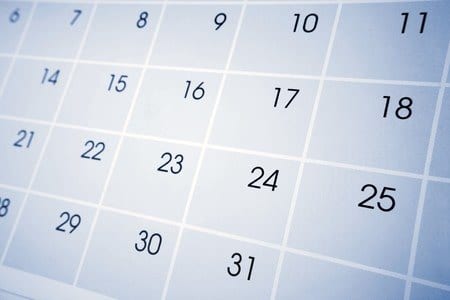Getting noticed with 'Three S Timing' for content marketing campaigns
 In my previous article covering the core tenets of the Watertight Marketing Framework, I looked at earning the right to a person's time. This can be achieved by developing a range of time-chunked materials will help you to steadily increase the amount of a person’s time they are willing to give you. Today, I'm moving on to deciding exactly when you put that material out there. That is, what month of the year, what day of the week, and what time of the day?
In my previous article covering the core tenets of the Watertight Marketing Framework, I looked at earning the right to a person's time. This can be achieved by developing a range of time-chunked materials will help you to steadily increase the amount of a person’s time they are willing to give you. Today, I'm moving on to deciding exactly when you put that material out there. That is, what month of the year, what day of the week, and what time of the day?
Once you have your range of materials mapped to a buying decision in place, you'll need to prepare a content marketing timing plan for its release. You can do this simply and powerfully with Three S Timing:
- Selectivity
- Scheduling
- Seasonality
Selectivity – showing up when they’re in a buying mood
You’ll often find that a customer reports that winning their business was a result of ‘lucky timing’. That is, you happened to show up when they were looking for what you sell. Luck has very little to do with this. What’s actually going on here is selectivity. And, it’s where marketing frequency is absolutely essential.
Have you ever noticed how when you learn a new word, it seems to crop up on the news, in the book you’re reading, or in conversation with a friend? It was always there, you just didn’t notice it. The same is true when you’re on the look out for a new car, you’ll suddenly see the model you have in mind passing you at every turn or parked next to you at the supermarket. This is a trick of the mind.
To enjoy the fruits of ‘lucky timing’, your company needs to crop up when a person happens to be thinking about what you’re buying. Which, effectively, means being there all the time. To do this, you need to commit to a number of regular marketing activities rather than one-offs, or big bang campaigns. The frequency of these will depend on buying cycles in your industry.
What you’re aiming for is to act a little like a lighthouse, with a beacon flashing regularly enough to be seen at the right moment. From a content planning perspective, this is about choosing the intervals at which you'll release each of your selected content types.
CASE STUDY: Comet Global Consulting
When Comet Global Consulting, customer technology specialists, were looking for some strategic marketing support, one of their directors recommended my consulting business. I had worked with him for about six months when I was in corporate marketing some three years earlier, and we had connected on LinkedIn. He had never signed up for a newsletter, or clicked on a blog. There was nothing to say he knew anything about my new business. Every week (without fail) I update my LinkedIn status with my latest blog post. This had the effect of just popping up in this buyer’s newsfeed regularly enough to express what I do. When it came to needing what I offer, he finally clicked on a link. But, without the previous 150-odd updates, he may not have noticed this one.
TIP: Commit to a releasing a set number of key marketing activities at regular intervals. For example, 6 daily Tweets, a weekly blog post, a monthly newsletter and quarterly paper with webinar.
Scheduling – showing up when you know they’re looking
With a commitment to a steady stream of ongoing activities, you can further increase your chances of showing up at the right time by understanding and matching your buyers’ work patterns and scheduling your communications to match.
Mapping a typical day, week and year for your buyers will help you to work out when to get in touch. For example, Mondays and Fridays probably aren’t best for your direct mail to arrive with a business person. And, calling a consumer at home during working hours is pretty futile.
The time of day you interact with your audience has radically altered with social media. You will definitely find people chatting business, and all manner of other things, outside normal working hours. Having social cover in these times can be really powerful. You'll never get chatting to #womeninbiz at #wineoclock if you're not online at this time.
TIP: Use scheduling tools to maintain a presence outside normal office hours. If you need to respond in these times, think about using a call-handling service and creating a social cover rota for the key social platforms.
Seasonality – tapping into moments of heightened need
There’s also seasonality to consider. Even if you’re not an ice-cream vendor, there will be seasonality in your market. Financial year-ends, school holidays, industry events, funding cycles and the like, can all lead to seasonal changes in demand or moments of heightened awareness.
Map things that happen over the course of a year that you could talk about or help with. There will be events that happen every year, like Valentine's day or getting your tax return in on time. Then, there will be one-offs in that year specifically, like a big sporting event in say London or Glasgow. The former should be worked into your ongoing marketing plan, the latter should form part of your specific 12-month plan.
There may also be dated triggers that relate to an individual or specific company, like their Birthday, or renewal dates, that would allow you to time your communications perfectly.
Case study: Desynit
Systems developers and Salesforce specialists, Desynit, have made brilliant use of seasonal events to create compelling content for their blog and social media. For Valentine's Day they posted - Making the Marketing Automation magic happen: An unlikely love story. The guys at Salesforce loved it, and featured it as a guest post on their global blog! At Easter, they issued their - Good Egg Awards. These featured people they've worked with and rate highly. It tapped into a seasonal moment, and with clever scheduling over the Easter weekend, allowed their social marketing to work brilliantly through a holiday period.
TIP: If you collect key data, like year-end or birthdays, when people sign-up for your email newsletter, you can set-up automated emails to go them at these times.
It would be such a shame for your brilliant content to miss its moment to shine, by simply not showing up when people are looking. Using this simple model to create a marketing timing plan for the release of your content will definitely increase your chances of getting noticed.
Image credit / Copyright: stillfx / 123RF Stock Photo
 Thanks to Bryony Thomas for sharing her thoughts and opinions in this blog post. She is the best-selling Author and Founder of Watertight Marketing, and a no-nonsense marketer and business speaker, specialising in helping ambitious small businesses set things up. Her blog post is adapted from her 5-star book, Watertight Marketing, described as an entrepreneur’s step-by-step guide to putting a marketing operation in place that delivers long-term sales results. You can download a free sample chapter, get all of Part One, or connect with her on LinkedIn, Twitter, Google+ or Facebook.
Thanks to Bryony Thomas for sharing her thoughts and opinions in this blog post. She is the best-selling Author and Founder of Watertight Marketing, and a no-nonsense marketer and business speaker, specialising in helping ambitious small businesses set things up. Her blog post is adapted from her 5-star book, Watertight Marketing, described as an entrepreneur’s step-by-step guide to putting a marketing operation in place that delivers long-term sales results. You can download a free sample chapter, get all of Part One, or connect with her on LinkedIn, Twitter, Google+ or Facebook.



 In my previous article covering the core tenets of the Watertight Marketing Framework, I looked at
In my previous article covering the core tenets of the Watertight Marketing Framework, I looked at 



